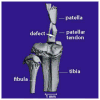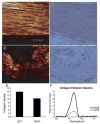Scleraxis expression is coordinately regulated in a murine model of patellar tendon injury
- PMID: 20740671
- PMCID: PMC3951487
- DOI: 10.1002/jor.21220
Scleraxis expression is coordinately regulated in a murine model of patellar tendon injury
Abstract
This study investigated the expression of Scleraxis in a murine model of patellar tendon injury in which the central third of the patellar tendon was unilaterally injured. The presence of tendon pathology was assessed using dual photon microscopy, conventional histology and microCT. Tendon pathology was also quantified noninvasively over a 12-week period using high-frequency ultrasound and laser Doppler flowmetry. Gene expression (Scx, Tnmd, and Col1a1) was determined at defined end-points (1, 4, 8, and 12 weeks) using qPCR on RNA from individual patellar tendons on injured and uninjured sides. There was significant development of tendon pathology as gauged by ultrasound and laser Doppler over 12 weeks. Injured tendons demonstrated significant histological and microCT evidence of pathological change, and disorganized collagen with reduced density. The expression of Scx and Col1a1 was unchanged at 1 week, significantly upregulated at 4 and 8 weeks, and had returned to baseline by 12 weeks. Tnmd expression was unchanged at 1 week, and significantly increased at 4, 8, and 12 weeks. Patellar tendon injury was associated with marked increases in the expression of Scx, Tnmd, and Col1a1. Our data suggest new roles for Scleraxis in coordinating the response to injury in the pathogenesis of tendon disorders.
Copyright © 2010 Orthopaedic Research Society.
Figures






Similar articles
-
The paratenon contributes to scleraxis-expressing cells during patellar tendon healing.PLoS One. 2013;8(3):e59944. doi: 10.1371/journal.pone.0059944. Epub 2013 Mar 26. PLoS One. 2013. PMID: 23555841 Free PMC article.
-
Scx-transduced tendon-derived stem cells (tdscs) promoted better tendon repair compared to mock-transduced cells in a rat patellar tendon window injury model.PLoS One. 2014 May 15;9(5):e97453. doi: 10.1371/journal.pone.0097453. eCollection 2014. PLoS One. 2014. PMID: 24831949 Free PMC article.
-
Altered fate of tendon-derived stem cells isolated from a failed tendon-healing animal model of tendinopathy.Stem Cells Dev. 2013 Apr 1;22(7):1076-85. doi: 10.1089/scd.2012.0555. Epub 2012 Dec 16. Stem Cells Dev. 2013. PMID: 23106341 Free PMC article.
-
Molecular dissection of tendon development and healing: Insights into tenogenic phenotypes and functions.J Biol Chem. 2025 Apr;301(4):108353. doi: 10.1016/j.jbc.2025.108353. Epub 2025 Feb 25. J Biol Chem. 2025. PMID: 40015639 Free PMC article. Review.
-
Acute traumatic rupture of the patellar tendon in pediatric population: Case series and review of the literature.Injury. 2017 Nov;48(11):2515-2521. doi: 10.1016/j.injury.2017.08.069. Epub 2017 Sep 1. Injury. 2017. PMID: 28888715 Review.
Cited by
-
Cellular distribution and gene expression profile during flexor tendon graft repair: A novel tissue engineering approach(*).J Tissue Eng. 2013 Jun 9;4:2041731413492741. doi: 10.1177/2041731413492741. Print 2013. J Tissue Eng. 2013. PMID: 23762501 Free PMC article.
-
Collagen scaffold-seeded iTenocytes accelerate the healing and functional recovery of Achilles tendon defects in a rat model.Front Bioeng Biotechnol. 2024 Dec 6;12:1407729. doi: 10.3389/fbioe.2024.1407729. eCollection 2024. Front Bioeng Biotechnol. 2024. PMID: 39713100 Free PMC article.
-
MMP inhibition as a potential method to augment the healing of skeletal muscle and tendon extracellular matrix.J Appl Physiol (1985). 2013 Sep;115(6):884-91. doi: 10.1152/japplphysiol.00137.2013. Epub 2013 May 2. J Appl Physiol (1985). 2013. PMID: 23640595 Free PMC article. Review.
-
Transcription factor EGR1 directs tendon differentiation and promotes tendon repair.J Clin Invest. 2013 Aug;123(8):3564-76. doi: 10.1172/JCI67521. Epub 2013 Jul 25. J Clin Invest. 2013. PMID: 23863709 Free PMC article.
-
Physiological loading of tendons induces scleraxis expression in epitenon fibroblasts.J Orthop Res. 2012 Apr;30(4):606-12. doi: 10.1002/jor.21550. Epub 2011 Sep 12. J Orthop Res. 2012. PMID: 21913219 Free PMC article.
References
-
- Hazleman B, Riley G, Speed CA. Soft tissue rheumatology. Oxford: Oxford University Press; 2004.
-
- Tallon C, Coleman BD, Khan KM, et al. Outcome of surgery for chronic achilles tendinopathy. A critical review. Am J Sports Med. 2001;29:315–320. - PubMed
-
- Maffulli N, Wong J, Almekinders LC. Types and epidemiology of tendinopathy. Clin Sports Med. 2003;22:675–692. - PubMed
-
- Jarvinen M, Jozsa L, Kannus P, et al. Histopathological findings in chronic tendon disorders. Scand JMed Sci Sports. 1997;7:86–95. - PubMed
Publication types
MeSH terms
Substances
Grants and funding
LinkOut - more resources
Full Text Sources
Miscellaneous

